BSP study: Rising heat also hurts PH economy
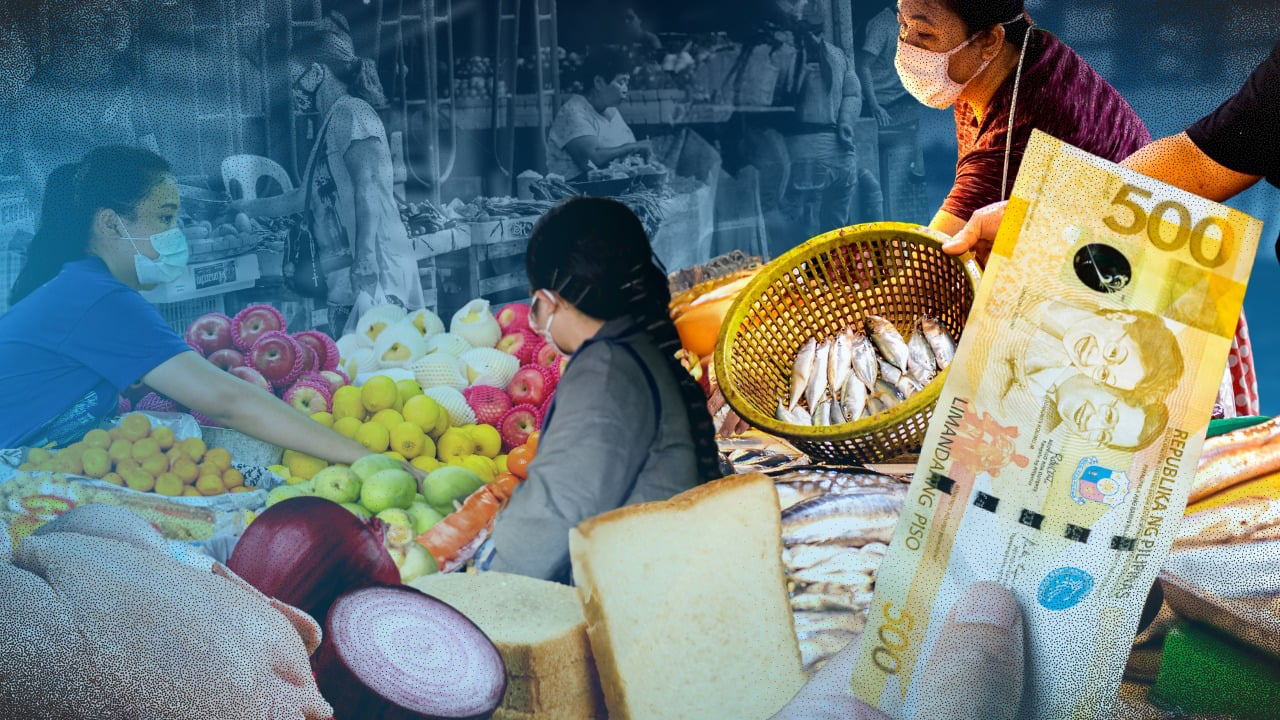
COMPOSITE IMAGE: INQUIRER FILE PHOTO
MANILA, Philippines—As the Philippines braces for higher temperatures ahead, a recent study revealed it’s not just the public that is wilting under the sweltering weather. As it turns out, the country’s economy is also feeling the heat.
Earlier this month, the Philippine Atmospheric, Geophysical, and Astronomical Services Administration (Pagasa) warned that the country, in the clutches of El Niño since July 2023, is set to endure continued heat and dryness along with a substantial reduction in rainfall in the coming months.
Ana Liza Solis, head of Pagasa’s Climatology and Agrometeorology Division, pointed out that the nation can expect significantly lower-than-normal rainfall conditions in March and April. Additionally, a drought is forecast for several provinces lasting until May, with high temperatures likely to prevail until the end of May or June.
Pagasa stressed that these conditions brought by El Niño could lead to a reduction in water supply, rising water costs, and an uptick in tropical, pulmonary, and food- and waterborne diseases across the country.
READ: El Niño, La Niña together? What to know
Article continues after this advertisementBut it’s not just our health and resources at risk. A paper released by the Bangko Sentral ng Pilipinas (BSP) showed that the warmer weather is also slowing down the country’s economic growth.
Article continues after this advertisementIn a first of its kind in the country, the BSP study explored how quick changes in temperature can immediately and progressively impact the Philippine economy.
The study specifically examined how temperature variations can affect the nation’s production, business operations, and price levels — factors that are crucial for the central bank when it decides on financial and banking strategies.
Higher temperature, slower growth
According to the study, for every degree rise in temperature, the country sees a small yet significant drop in the overall growth of the economy.
“We find that, on average, the short-run marginal impact of a 1-degree Celsius increase in the country’s annual mean temperature reduces aggregate output growth by 0.37 percentage points (ppt),” the study revealed.
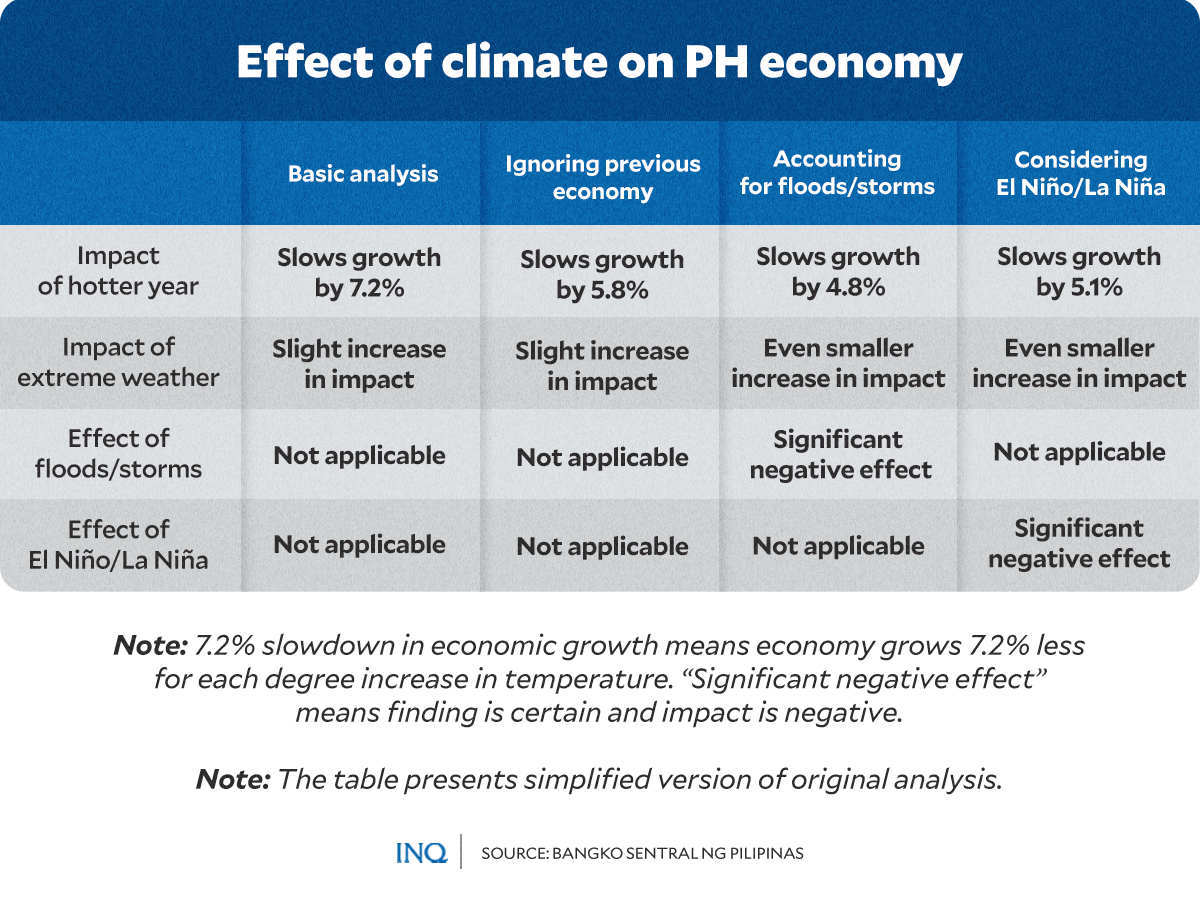
GRAPHIC Ed Lustan
Its authors explained that the finding stays the same even after applying different model specifications.
They stressed that during El Niño Southern Oscillation (ENSO) events, the country’s economic growth decreases by an additional 0.47 percentage points. This is a more significant drop compared to the 0.30 percentage point decline observed during periods of floods and storms.
READ: Extreme heat in PH: Health risks, economic impact
The study further found that the impact of a 1-degree Celsius rise in average temperature — also referred to by the authors as “temperature shocks” — on economic growth differs among the major island groups in the country, showing a decrease ranging from 0.16 to 0.47 percentage points.
Although findings emphasized that the temperature increase’s effect on economic growth is statistically insignificant in Mindanao, the authors clarified that when considering El Niño events, the negative impact on the economy becomes significant across all major island groups.
Long-term impacts
In terms of long-term effects, the study highlighted that temperature fluctuations have no substantial impact on national economic output. However, accounting for flood and storm events, the cumulative economic growth decline reaches 1.12 percentage points over eight years following such temperature shocks.
“The results present important implications on the significance of government policies pertaining to climate change adaptation (CCA) and disaster risk management (DRM) alongside the long-term agricultural productivity-enhancing program,” the study authors wrote.
“Likewise, the findings highlight the importance of increased spending and investment on agricultural research and development to reinforce the resiliency and adaptation of agriculture sector to climate change,” they added.
Referencing the Organisation for Economic Co-operation and Development (OECD), the researchers noted that the Philippines has set up institutions and policies for DRM and CCA, including efforts to improve data gathering and financial tools designed to boost resilience against climate-related disasters.
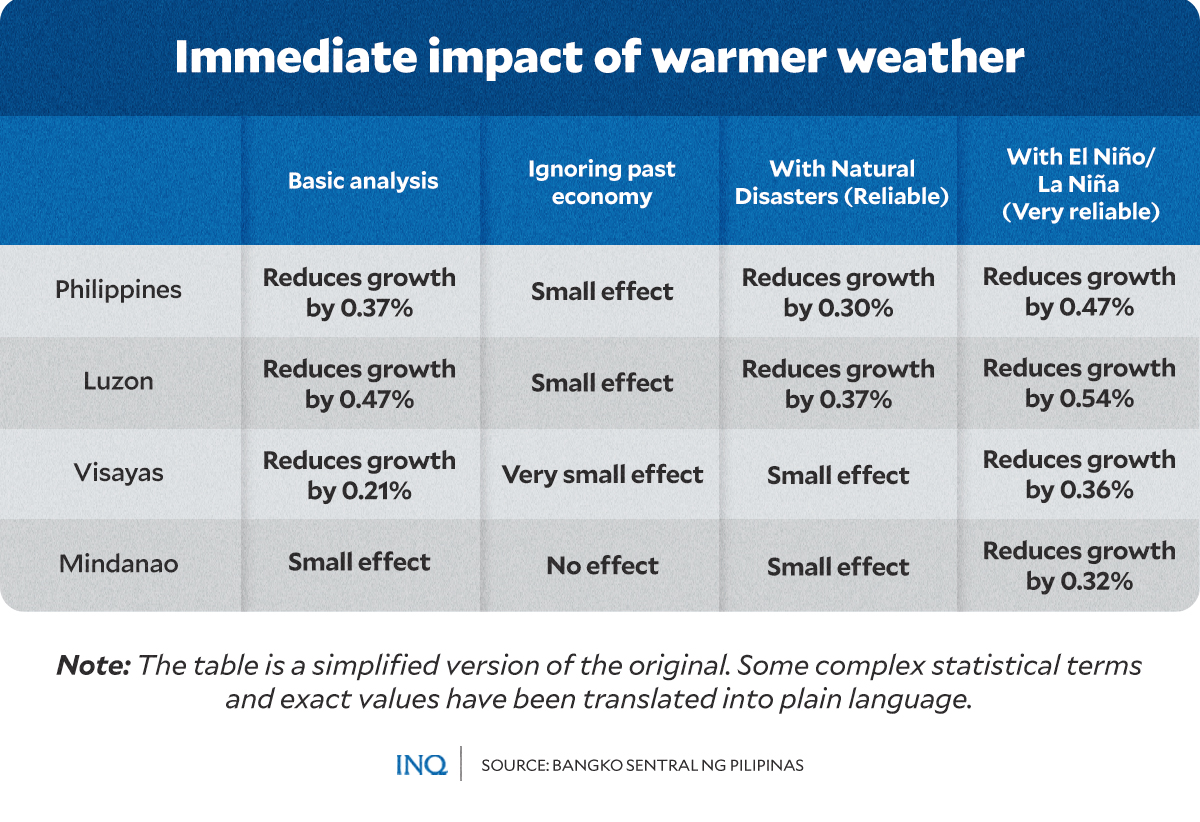
GRAPHIC Ed Lustan
However, despite a strong conceptual alignment in policies and institutional structures for CCA and DRM, the actual progress in executing these plans has been sluggish in various sectors.
The researchers said this is due to overlapping strategies, action plans, methodologies, and reporting systems, further hindered by a lack of resources and expertise at the local government level.
“Thus, it is crucial to strengthen the institutional, technical, and financial capacity of concerned groups to develop CCA and DRM plans for its effective implementation given the potential impact of climate-related risks to output growth,” the researchers said.
Varied impacts on food production
The study further elaborated on how temperature fluctuations affect crop production differently, showing that palay and corn experience adverse effects, in stark contrast to mango production, which responds differently to the same temperature changes.
“For palay and corn, the impact of 1℃ increase in annual mean temperature is negative at -1.83 ppt and -3.51 ppt, respectively,” the researchers explained.
“However, for mango production, results showed positive effect as mangoes prefer climate conditions with warm temperatures and light amount of rainfall especially during fruit development stage,” they added.
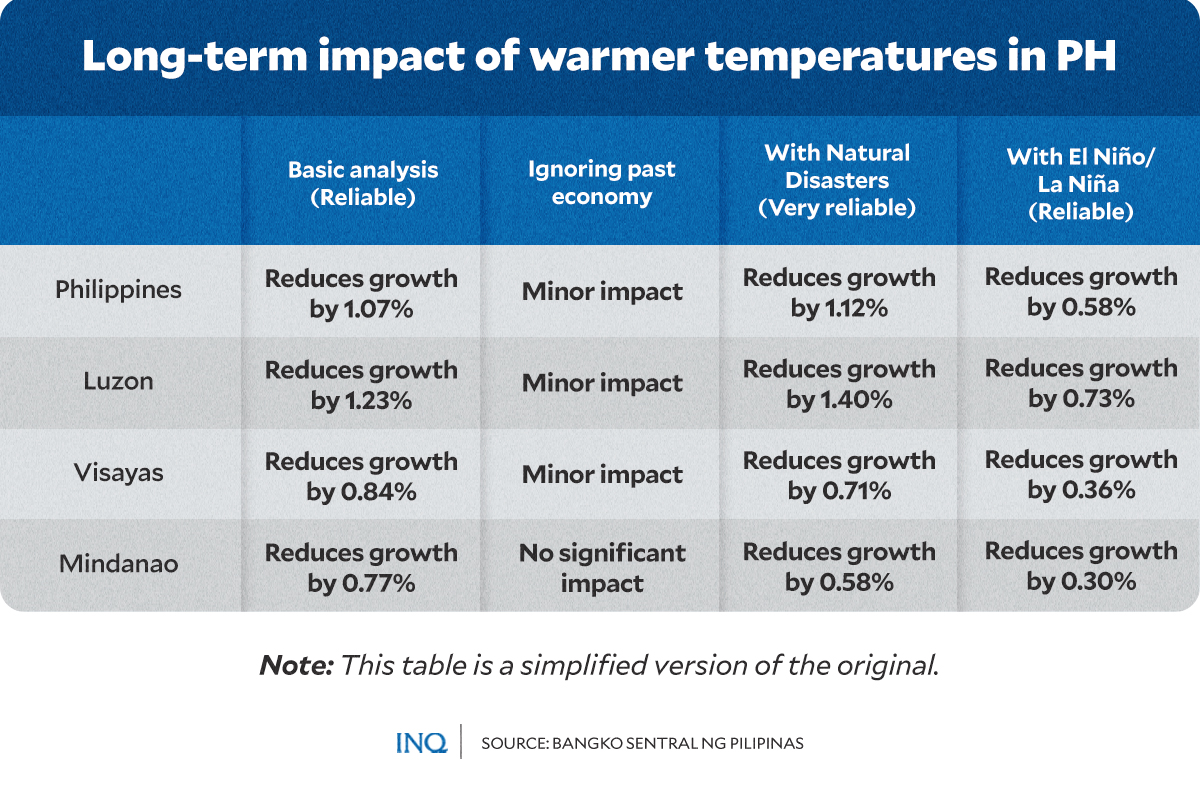
GRAPHIC Ed Lustan
The researchers found that temperature increases don’t have a major effect on the fishing industry overall or when looking at different regions or islands. They attributed this to the proactive plans and programs of the Bureau of Fisheries and Aquatic Resources (BFAR) that can help handle the changing environment.
These include setting up systems to respond to environmental risks quickly, creating more diverse ways for people to make a living from the sea, expanding fish farming into areas that were unused or had failing farms, starting special projects for fish that are valuable, and doing more research to help the industry.
Higher temperature, high food prices
When the average yearly temperature goes up by 1 degree Celsius, the researchers said prices in the country tend to rise, and this effect can last up to four years.
This is most noticeable in the cost of food, which can remain higher for a long time. For other items, like those outside of groceries, the price increase is smaller and doesn’t last as long, often just up to two years.
READ: How El Niño could impact health, food and the economy
“The food consumer price indicator is an important variable to look at when understanding the impact of temperature shocks on inflation dynamics in the country since food-related items account for 35 percent of the Filipino consumer’s basket,” the researchers said.
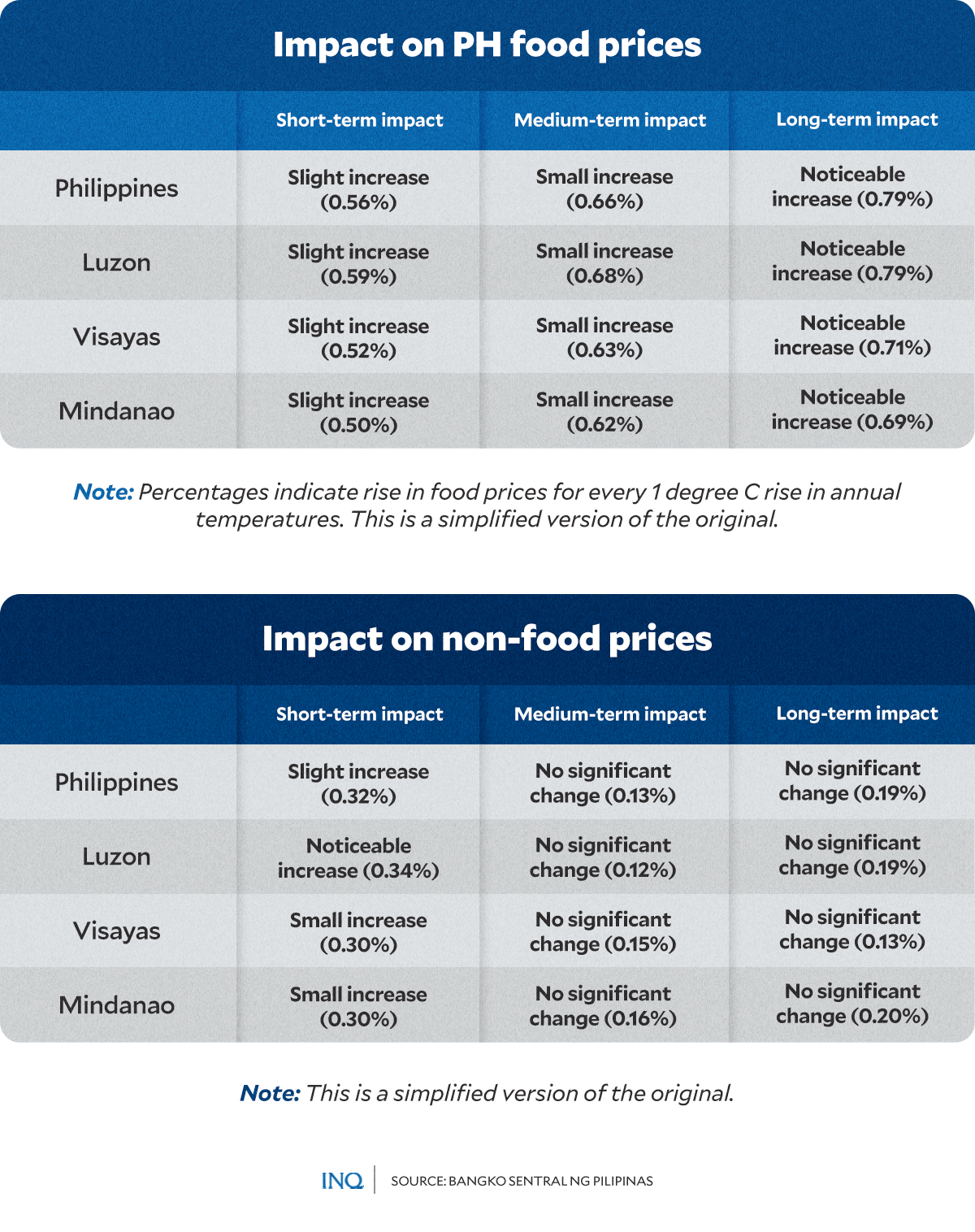
GRAPHIC Ed Lustan
“Keeping prices stable, particularly for key food items, will help ensure strong and sustainable economic growth and better living standards,” the study said.
“However, with inflation being driven by supply-side shocks over the past years, the increasing food inflation also highlights the Philippines’ vulnerability to supply constraints,” it added.
How heat impacts workers, productivity
Interestingly, the study looked into how much work people can do in hot conditions and found that an increase in temperature by 1 degree Celsius doesn’t necessarily lead to less work being done right away.
“The results possibly imply that workers in the construction and transportation sectors are already used to the weather conditions in the country,” the researchers stressed.
“Likewise, in the transportation sector, jeepney and taxi drivers operate on a quota- and boundary-based system such that regardless of the weather conditions, they still need to work to either meet their daily quota or earn back their ‘boundary fees’,” they added.
Moreover, the study implied that in the Philippines, other factors like outdated equipment, not enough managers, and workplace safety can also make it hard for people to do their jobs effectively.
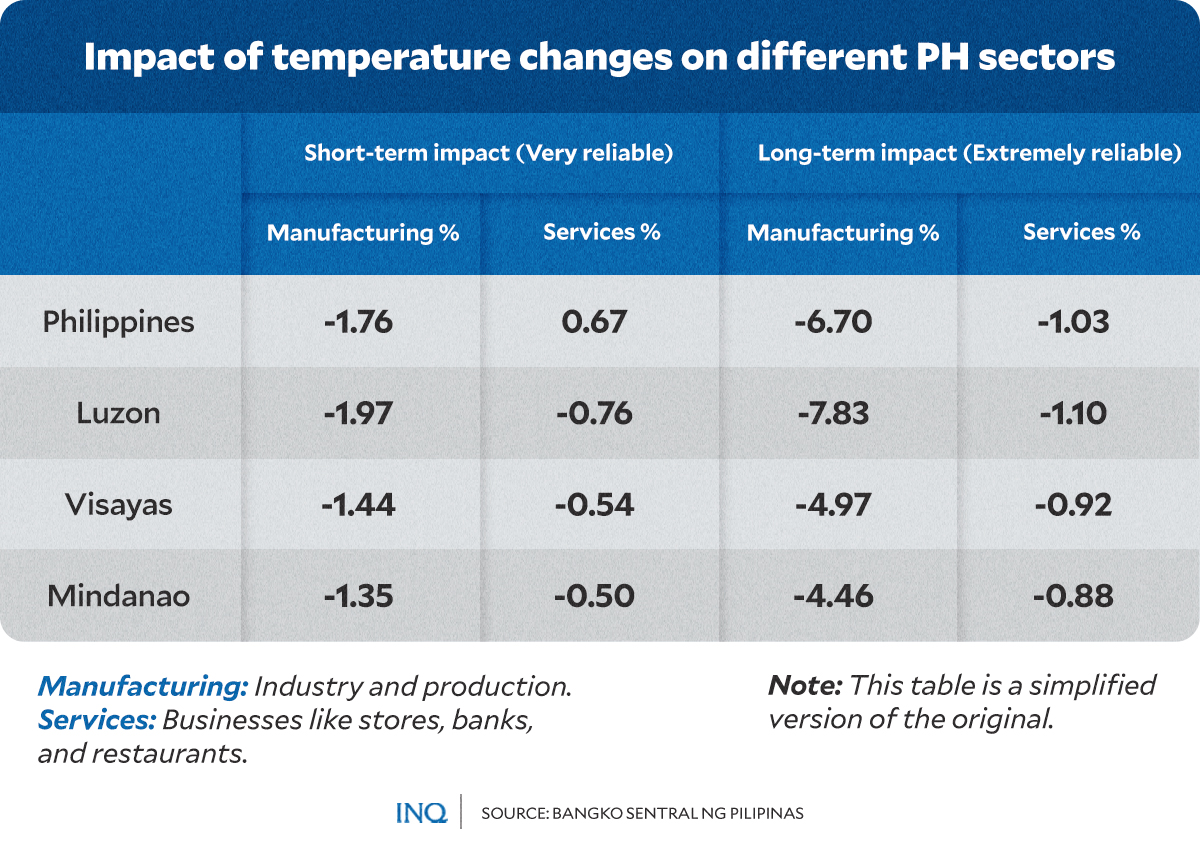
GRAPHIC Ed Lustan
When it comes to making things, like in factories, and providing services, the study found that hotter temperatures lead to a decrease in the amount of work done.
The heat hits manufacturing harder than the service sector, with a more noticeable drop in production.
What needs to be done
The study indicated that the impact of temperature rises on inflation and the cost of living is more long-lasting for food than for other goods. The researchers stressed that this underlines the importance of the BSP and government working together to implement timely measures to prevent these from becoming more severe.
“The findings on the varying impact of rising temperature on different crops can also inform the work of financial regulators, including the BSP, as they strive to create a conducive environment with due regard to having appropriate incentive structures that would encourage financial institutions to offer crop-targeted loan packages and insurance coverage,” the researchers added.
“This means that loans and insurance policies could be tailored more specifically to the needs of different crops, which would be a step towards smarter, more climate-aware economic planning,” they explained further.
RELATED STORIES:
PH among nations most at risk to El Niño
Economy to stay strong despite El Niño impact on agriculture